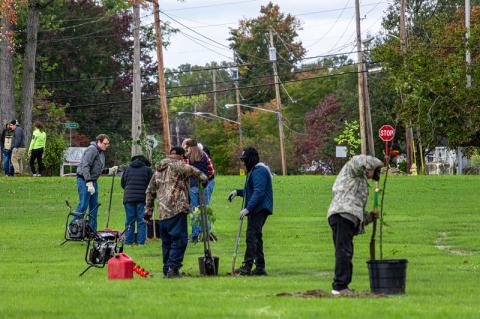How one northeast Ohio city is tackling urban blight

Listen to this Episode
A decade ago, there were more than 1,500 vacant homes in the northeast Ohio city of Warren.
The area’s population fell rapidly following the industrial decline of the 1980s, leaving behind a trail of empty buildings.
But one local organization is working to address those vacancies.
The Trumbull Neighborhood Partnership, the area’s community development corporation, has demolished about 1,200 vacant properties and renovated more than 600 in the past decade, according to its 2024 Parcel Inventory Update.
The organization partners with the city of Warren and Trumbull County, and it has received state and federal support to carry out this work as well.
“When we first started just two or three years after the foreclosure crisis when there was the most vacancy ever, everywhere, our focus at that time was triage,” said the organization’s executive director, Matt Martin. “Demolish what needs to be demolished, save what we can, and then figure out a land-use plan.”
Now, only about 400 vacant buildings remain in the city. But Martin says there’s a lot more work to be done.
“We're still trying to clean up and reimagine and rightsize our community,” he said.
A history of housing in Warren
At a time when much of Ohio is facing a housing shortage, Warren is in much different shape.
Between 1970 and now, its population fell dramatically — from more than 60,000 people at its peak to around 39,000 at present.
“It is similar to a lot of communities throughout this region of the country where the outsourcing and offshoring of manufacturing jobs led to the closure of multiple factories over a period of time,” Martin said. “So you see, in Warren, slow and steady population loss.”

The housing stock reflected that.
“So we don't have the kind of overall raw [housing] shortage that you see in larger metros,” Martin said. “We just don't.”
Instead, Warren has an excess of houses, and those that have been vacant for a long time are often uninhabitable, requiring thousands of dollars in renovations, if they’re reparable at all. Many are demolished entirely.
“We field the question a lot, especially in the last three years: how can you tear down houses when people need them?” Martin said. “Well, it's not exactly generous to give somebody a house that needs $100,000 worth of work, especially in a neighborhood where houses are worth $40,000 or $50,000.”
On top of that, vacant houses drive down property values for people living nearby, and they drive up crime. Those factors can push even more people out of an area.
So, tearing down and renovating vacant properties helps stabilize the housing stock, and therefore the population.
“The removal of the vacant houses has made a huge quality of life difference,” Martin said. “I hear that from folks all the time. What the community looked like about 10 years ago in the years after the foreclosure crisis, the city deserved better than that. And so I think what we've been able to do has really helped.”
What’s next for Warren?
But it’s not all roses, Martin said. The city’s next step is figuring out what to do with empty land where vacant houses once stood.
“When we drive around now, there's a lot of vacant lots,” he said.

Many of these lots are sold to neighbors at very low prices.
“If there is a neighbor next door — preferably an owner-occupant that's paid up on their taxes and doesn't have any code violations of their own — we can sell them that lot, usually for as little as $200,” Martin said.
Other lots are turned into community gardens, filled with flowers and vegetables.
Still, more sit empty.
“And that's certainly something that we have to think about,” Martin said.
But he’s hopeful for what the future will bring.
“I'm really proud of the work we've done to help get some of these neighborhoods ready for what possibly could be new investments,” he said, “and maybe some new folks that want to relocate, or even just our residents that want to stay here.
“I think the next chapter for Warren is really exciting.”
9(MDYwODMwNTczMDE2ODk5NTExNDAyNzM5Ng000))
- Home
- Schedules
- TV
- TV
- Local TV Programs
- Business | Life 360 with Kristi K.
- Toledo Stories
- To The Point with Doni Miller
- Listening with Keith Burris
- Ideas & Insights
- WGTE Presents
- BL360: Northwest Ohio Innovation Consortium
- Magic of the Old West End
- Freedom Means Never Surrender
- I&I: The Random Factor
- FF: National Cherry Festival
- TTP: Moms Demand Action For Gun Sense in America
- Watch Live
- Radio
- Education
- Community
- Support
- About
- Donate
- Watch Live


